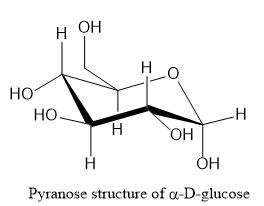
Complete hydrolysis of starch gives:
A) glucose and galactose in equimolar amounts
B) galactose and fructose in equimolar amounts
C) glucose only
D) glucose and fructose in equimolar amount
Answer
558.3k+ views
Hint:Consider the monosaccharide units present in starch. Thy hydrolysis of a polysaccharide gives monosaccharides as the final product.
Complete answer:
We can represent starch with chemical formula \[{\left( {{{\text{C}}_6}{{\text{H}}_{10}}{{\text{O}}_5}} \right)_n}\] . Starch is a polymer or a polysaccharide. The monosaccharide unit present in starch is \[\alpha - D - \] glucopyranose unit.
Starch is insoluble in cold water, but We can prepare a colloidal solution of starch by grinding and soaking. On partial hydrolysis of starch and glycogen, We can obtain the disaccharide maltose and a low molecular weight dextran. Upon hydrolysis of starch We can get two fractions. The first fraction is around 20% of the hydrolyzed product. This fraction contains amylose that is water-soluble.
Amylose contains a linear chain that is made from several thousand glucose units. The second fraction that We obtain is called amylopectin. It contains around one million glucose units. Amylopectin is a branched polymer and is water-insoluble. Hence, when we subject starch to complete hydrolysis, We get \[\alpha - D - \]glucose as the sole product.
Let us write the structure of \[\alpha - D - \] glucopyranose as shown below:


Note:Starch is a high molecular weight polysaccharide consisting of amylose and amylopectin. Amylose is a linear polymer and is around 20% of starch. Amylopectin is branched polymer and is around 80% of starch.
Complete answer:
We can represent starch with chemical formula \[{\left( {{{\text{C}}_6}{{\text{H}}_{10}}{{\text{O}}_5}} \right)_n}\] . Starch is a polymer or a polysaccharide. The monosaccharide unit present in starch is \[\alpha - D - \] glucopyranose unit.
Starch is insoluble in cold water, but We can prepare a colloidal solution of starch by grinding and soaking. On partial hydrolysis of starch and glycogen, We can obtain the disaccharide maltose and a low molecular weight dextran. Upon hydrolysis of starch We can get two fractions. The first fraction is around 20% of the hydrolyzed product. This fraction contains amylose that is water-soluble.
Amylose contains a linear chain that is made from several thousand glucose units. The second fraction that We obtain is called amylopectin. It contains around one million glucose units. Amylopectin is a branched polymer and is water-insoluble. Hence, when we subject starch to complete hydrolysis, We get \[\alpha - D - \]glucose as the sole product.
Let us write the structure of \[\alpha - D - \] glucopyranose as shown below:


Note:Starch is a high molecular weight polysaccharide consisting of amylose and amylopectin. Amylose is a linear polymer and is around 20% of starch. Amylopectin is branched polymer and is around 80% of starch.
Recently Updated Pages
A man running at a speed 5 ms is viewed in the side class 12 physics CBSE

State and explain Hardy Weinbergs Principle class 12 biology CBSE

Which of the following statements is wrong a Amnion class 12 biology CBSE

Two Planoconcave lenses 1 and 2 of glass of refractive class 12 physics CBSE

The compound 2 methyl 2 butene on reaction with NaIO4 class 12 chemistry CBSE

Bacterial cell wall is made up of A Cellulose B Hemicellulose class 12 biology CBSE

Trending doubts
What are the major means of transport Explain each class 12 social science CBSE

Which are the Top 10 Largest Countries of the World?

Draw a labelled sketch of the human eye class 12 physics CBSE

Explain sex determination in humans with line diag class 12 biology CBSE

Give 10 examples of unisexual and bisexual flowers

State the principle of an ac generator and explain class 12 physics CBSE




